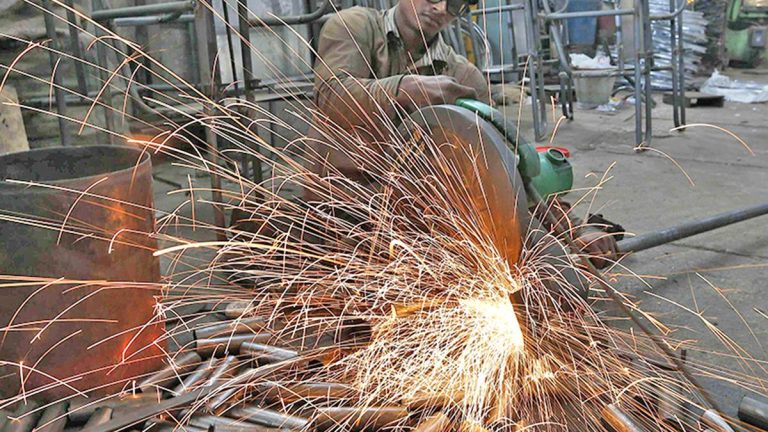Steel, a vital component of infrastructure and economy, contributes massive environmental damage in its production process as it relies heavily on coal as a fuel. In the steel production process, carbon (primarily sourced from coal and natural gas) reacts with iron ore to produce molten iron, which is then refined to create steel. This process generates vast amounts of carbon dioxide (CO2) and as a result, the steel industry alone, globally, emits over 3.7 billion metric tons of CO2 every year, contributing to 7–9 % of carbon emissions.
To combat the issue, a team of researchers, Arnab Dutta, Sukanta Saha, Suhana Karim and Santanu Ghorai, from the Chemistry Department at the Indian Institute of Technology Bombay (IIT Bombay) have come up with a set of sustainable catalysts for generating green hydrogen that can be utilised in steel making process via hydrogen-based direct reduction of iron (H-DRI) method.
In a recent review published in the Journal of Energy and Climate Change, researchers from IIT Bombay, led by Professor Arnab Dutta, have collated the advances made in the field of hydrogen generation for the steel industry and put forward the best way to decarbonise the steel industry using ‘green’ hydrogen.
The H-DRI process uses hydrogen to convert iron ore into steel instead of coal, releasing water vapour rather than carbon dioxide as a byproduct during the manufacturing process. This makes hydrogen a great option for decarbonising the steel industry.
Currently, most of the hydrogen comes from processes like steam methane reforming or coal gasification that rely on fossil fuels and still generate CO2.
To produce hydrogen sustainably, researchers are shifting towards water electrolysis — a process of splitting water into hydrogen and oxygen using electricity in an electrolyser device. If renewable energy sources like wind or solar can power the electricity, the process becomes emission-free, hence the term ‘green hydrogen’, Mr. Dutta said.
However, producing green hydrogen at an industrial scale is expensive as it needs considerable infrastructure modifications and effective catalysts that are essential to make the water electrolysis used for hydrogen production effective.
Suhana Karim, a postdoctoral research fellow said, “Generally, noble metals such as platinum and palladium are used as catalysts. These noble metals are expensive and limit large-scale applications and are not suitable for harsh or remote conditions. So, the focus is on finding alternatives that are economically viable and sustainable.”

Prototype of a multi-stack electrolyser developed by the IIT Bombay research group.
| Photo Credit:
Special Arrangement
Researchers worldwide, including the IIT Bombay’s team, are developing cobalt-based catalysts (cobaloximes) that are water soluble and air-stable to aid electrolysis without requiring specialised equipment. Cobaloximes are cheaper than noble metals and can be synthesised easily. Several researchers have improved the stability and reaction rates of cobaloximes by modifying their molecular structure.
For example, the IIT Bombay’s research team has added natural amino acids, vitamins, and other functional groups into the catalyst’s structure to increase hydrogen production rates while maintaining energy efficiency. Ms. Karim said that they have also modified cobaloximes to work effectively in the presence of various minerals and salts, such as in seawater.
Cobaloximes work well in labs, but it is complex to use them for industrial hydrogen production. Hence, researchers are modifying their structure to make it compatible with the electrodes of the electrolyser and attaching them to solid supports to enhance stability, efficiency, and durability, she added.
The researchers also analysed different types of electrolysers and furnaces to improve hydrogen production using renewable energy for industry and found that cobaloxime catalysts perform well in both alkaline electrolysers, using solutions like potassium hydroxide, and proton exchange membrane electrolysers, which use a solid polymer membrane in acidic conditions.
Mr. Dutta explained, “Each type has strengths and weaknesses in cost, durability, and efficiency. In an electrolyser, when an electric current is passed through water, it splits, and hydrogen gets collected at the negative electrode (cathode) and oxygen at the positive electrode (anode). A complete set of electrodes, including a membrane, called a ‘stack’, separates the hydrogen and oxygen generation during electrocatalysis. Using multiple stacks, the electrolysers work more efficiently to produce copious amounts of hydrogen and can cut CO2 emissions by 30–50%, making the hydrogen-based energy economy more sustainable.”
A single stack might produce one litre of hydrogen per day, but an appropriately designed multi-stack system can produce ten times as much using the same control setup, he added.
The researchers also pointed out that the traditional blast furnace-basic, the oxygen furnace method uses a lot of coal to produce steel, releasing a significant amount of CO2 . In contrast, the electric arc furnace uses electricity, and when powered by renewable energy, it produces less carbon emissions. The team believe that by combining hydrogen-based direct reduction of iron with electric arc furnace technology, steelmaking can become nearly carbon-neutral.
The use of green hydrogen can further be combined with carbon capture, utilisation, and Carbon Capture, Utilisation and Storage (CCUS) storage strategies to further reduce emissions. CCUS systems capture any leftover CO2 from steelmaking or other processes, allowing its use to produce synthetic fuels or chemicals or stored deep underground for the long term. This approach also promotes a circular economy by reusing CO2 in productive ways.
The IIT Bombay study highlights how water electrolysis using cobalt-based catalysts, and choosing suitable electrolysers and furnace types, can produce green hydrogen-based steel and thus help significantly reduce carbon emissions for a sustainable future in steel production.
Published – February 25, 2025 09:00 am IST

